Table of Contents
Conveyor belt fires can present a serious hazard in the confined environment of an underground coal mine. To minimize this hazard, Federal regulations were enacted following the Federal Coal Mine Health and Safety Act of 1969 to require the use of acceptable fire-resistant conveyor belts and suitable belt slippage-sequence switches, fire warning devices, and fire suppression systems. The schedule 2G fire resistance test, as defined in the Code of Federal Regulations (Title 30, Part 18), has been used for many years for the approval of mine conveyor belts by the Bureau of Mines and, more recently, the Mine Safety and Health Administration (MSHA). Although available fire statistics show that relatively few conveyor belt fires have been reported for underground coal mines in recent years, there is still cause for concern for the following reasons:
- The number of belt fires can be much greater than reported since those extinguished within 30 min need not be reported, except where a fatality or potentially fatal injury has occurred.
- The schedule 2G test is severely limited by its small scale and does not provide a sufficient reliable measure of fire resistance for application to mine fire conditions.
- The schedule 2G test is largely qualitative and is not designed to provide information on the flame spread rate; that is, the propagation stage.
The inadequacy of small-scale belt fire tests was demonstrated in the works by Mitchell and Warner. Both investigators showed that certain neoprene (NP) and polyvinyl chloride (PVC) belts, that had been approved by schedule 2G, were nevertheless capable of propagating flame over their entire length when full-scale fire conditions were simulated. The National Coal Board of the United Kingdom and the regulatory agencies of other European countries have also been concerned with this problem and require full-scale fire tests or a combination of a small-scale flammability test and a drum friction test to evaluate their belts. Generally, PVC belts tend to give the least reliable results in small-scale flammability tests. The fire resistance test described in this report was developed to overcome the limitations of the schedule 2G method and to provide quantitative ratings that could be correlated with practical fire situations.
To obtain the necessary data to design the test apparatus, full-scale fire tests were conducted with several representative conveyor belts in a large fire gallery at the Factory Mutual Research Corp., as part of an ongoing Bureau of Mines contract; the test section of the gallery measured 2.43 by 2.43 by 45.7 m. Air velocity, ignitor flux, and belt distance from the gallery roof were the most important variables. Based upon this information, a moderately scaled apparatus was constructed and evaluated under various test conditions using the same belts as in the contract work. The final apparatus design is described which provides a measure of the ignitability and flammability (flame spread) properties of the belt. A fire resistance index is proposed to rate different conveyor belts and the ratings are compared with those obtained by other methods.
The fire-resistant and nonfire-resistant conveyor belts that were examined in the present work are shown in table 1. Except for the nonfire-resistant rubber belt, all belts met the fire resistance requirements as defined by the MSHA schedule 2G test.
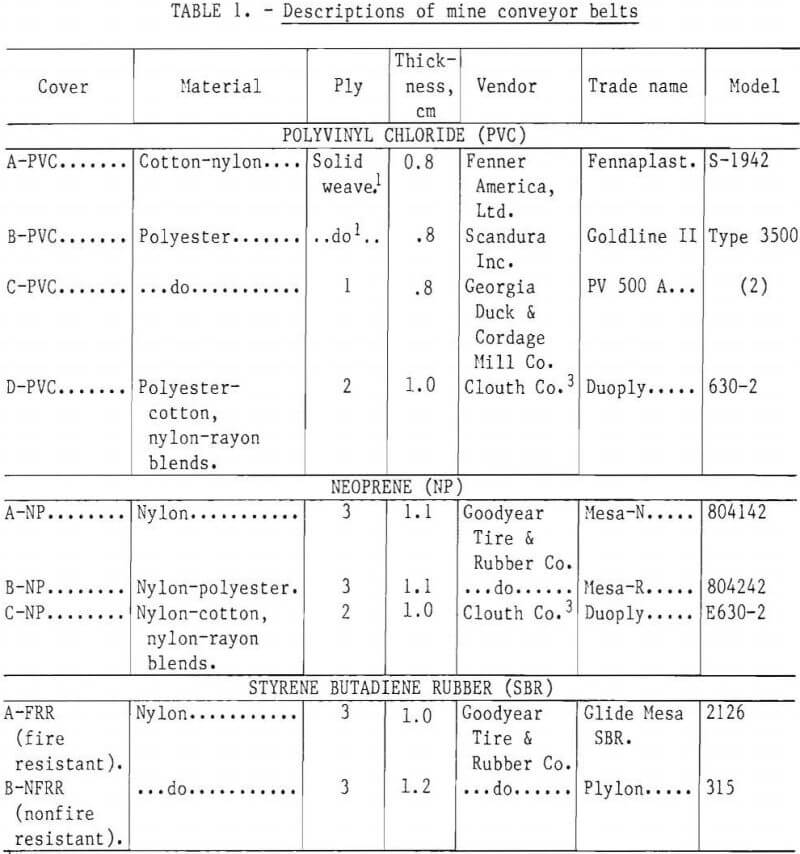
Experimental Apparatus and Procedures
Flammability Apparatus
A moderate-scale flammability apparatus was developed to evaluate the fire resistance characteristics of mine conveyor belts. The general design of the apparatus was based upon data from full-scale fires, particularly those conducted in the fire gallery at Factory Mutual under a Bureau contract.
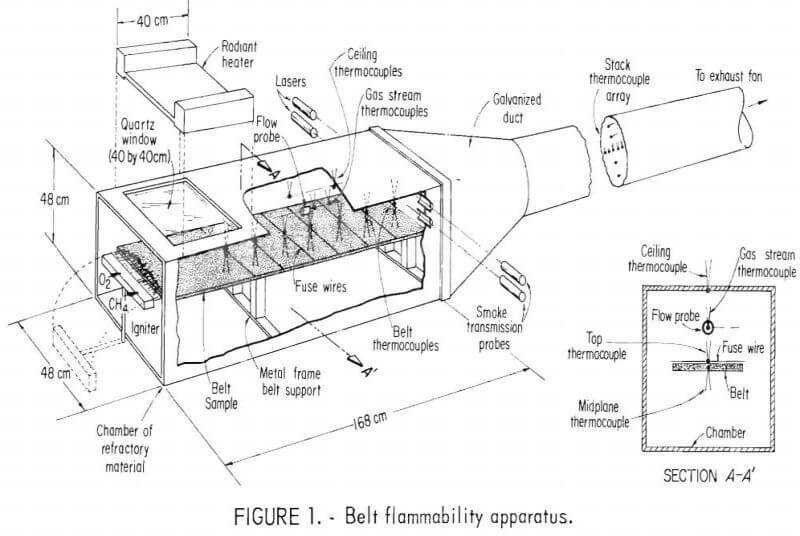
A scaled-down version was developed considering geometrical similitude and designed to define ignitability and flammability properties of the belt when burned in a horizontal attitude. A schematic diagram of the apparatus is shown in figure 1. The test chamber measures 48 by 48 by 168 cm and is fabricated of 1.25-cm-thick Maronite or similar refractory material. It is equipped with an adjustable stainless steel rack to mount the belt samples and can accommodate samples up to 46 cm wide and 152 cm long. The steel rack consisted of two 1.9-cm-wide members to which the sample is fastened with sheet metal screws and adjusted to the desired height. Other components of the apparatus include an air ventilation system; a fuel gas ignition source; a radiant panel to preheat the belt; and instrumentation to measure air velocities, air and belt temperatures, flame spread rates, heat release rates, and relative smoke densities.
The test chamber was ventilated by a variable speed fan that was mounted at the exit of a 40.6-cm-ID galvanized steel exhaust duct. Flow capacity of the fan was 40 m³/min which could provide air velocities up to 185 m/min in the rectangular test section. Air velocity was measured by a bidirectional flow probe in conjunction with an ultrasensitive, differential pressure transducer with a sensitivity of ±0.7 cm water. The probe was located midway between the belt and ceiling, approximately 50 cm from the upstream end of the belt. Also included in the test facility, but not shown, was an overhead exhaust hood at the inlet to prevent combustion products from escaping into the laboratory in the event of flow reversal.
A radiant panel is included in the apparatus to preheat the belts and to help promote ignition. The panel consisted of three high-power density, infrared heaters that were water-cooled and driven by a silicon-controlled rectifier. Radiation from this bank of heaters passed through a 40-cm-square, 0.64-cm-thick quartz window that was recessed in the ceiling of the chamber. The heater-window combination was capable of producing heat fluxes up to 1 cal/cm² sec over the belt section being ignited.
The ignitor source was a methane-oxygen ribbon burner (Bethlehem Apparatus Co.) with multiple precisioned ports that provided a flame cross section of 0.8 by 15 cm at the burner base. Burner output was controlled by metering stoichiometric proportions of methane and oxygen through calibrated flow- orifices; this fuel mixture has an adiabatic flame temperature of 3,050 K. As shown in figure 1, the burner is mounted at the chamber inlet and could be rotated 90° out of the way after the ignition period. During ignition, the burner is positioned at the same height as the top surface of the belt with the gas ports nominally 2 cm from the leading edge. The flame of the burner impinged upon the leading edge of the belt and extended approximately 8 cm over the top surface but only slightly over the bottom surface. With the size burner selected, the burner flame extended over at least one-half of the belt width for the widest sample used (30.5 cm).
Belt and chamber temperatures were measured during each test to characterize the burning of the belts. These were made with 20 B&S gage chromel-alumel thermocouples at eight stations that were spaced 15.5 cm apart along the longitudinal axis of the belt: the first station was 41 cm from the upstream end (preheated section) of the belt. At each station (figure 1- section A-A’), four thermocouples were distributed as follows: (1) in mid-plane of the belt, (2) at top surface of the belt, (3) in gas stream midway between the belt and chamber ceiling, and (4) at the ceiling slightly within the refractory. In addition, an “X” array of thermocouples was mounted in the exhaust duct to measure mean exit gas temperatures; the eight off-center thermocouples were wired in parallel and the center thermocouple was wired separately. The belt temperatures were used to determine flame spread rates and the gas stream temperatures were used to calculate heat release rates caused by combustion.
Flame spread rates were also measured by use of 1-amp fuse wires that were mounted across the belt surface at each station. Arrival of flame at the fuse wire was detected by a sudden change or interruption of voltage in an electrical break circuit owing to a melt and break of the fine wire. These and all other sensor outputs were recorded on the magnetic tape of a 100-channel data logger and subsequently processed by a digital computer system.
In addition, relative levels of smoke generation were measured, although this hazard is not included in the schedule 2G fire resistance requirements for conveyor belts. These measurements were made by the light transmission method at two vertical levels just at the end of the rectangular test chamber. The light sources were two Coherent Radiation lasers (10-mw model, 6328 A), and the attenuation of smoke was detected by silicon photodiode sensors. The lasers were arranged so that the beam passed through short lengths of stainless steel tubes that extended into the chambers from both sides. The external ends of the tubes were sealed with 2.5-cm-diam quartz windows and separated to provide a fixed transmission path of 15.2 cm. The measured attenuations of light transmission (I/I0) were used to calculate absorption coefficients by the following form of the Bouger-Beer-Lambert transmission law:
I/Io = exp (- kl)…………………………………………(1)
where k is the attenuation coefficient (cm -1) and l is the beam path length (15.2 cm).
Test Procedure
To conduct an experiment, the air flow is first preset at the desired rate and the infrared preheaters are turned on for a predetermined period (fig. 2). During this period, visual observations of the heated zone are made, such as the amount of belt swelling and charring. After this period, the burner flame is applied to the belt and the radiant panel turned off. Figure 3 shows a fire-resistant belt beginning to burn extensively after 1 min into the ignition period. At the end of the ignition period, the burner is removed and the sample allowed to burn until the flame either extinguishes itself or the thermocouples and fuse wires indicate burning at the last monitoring station. Belt and chamber temperatures are continuously recorded throughout the test.
The tests are terminated by extinguishing the flame with a portable CO2 extinguisher. Since toxic products are generated in these tests, the exhaust gases are passed through an adequate scrubber before venting to the outside atmosphere. To optimize the ignition and burning conditions, it is necessary to know the effects of test variables that need to be controlled. These include belt width and height, air velocity, preheat flux intensity and duration, and ignition flux intensity and duration. In addition, consideration must be given to possible great variations in the composition of a given belt lot or between different lots due to poor quality control by the manufacturer. In the present work, the results refer primarily to samples taken from various sections of the belt roll. The ASTM critical oxygen index test was used to monitor belt quality control, although sufficient data were not obtained to properly evaluate the method for this purpose.
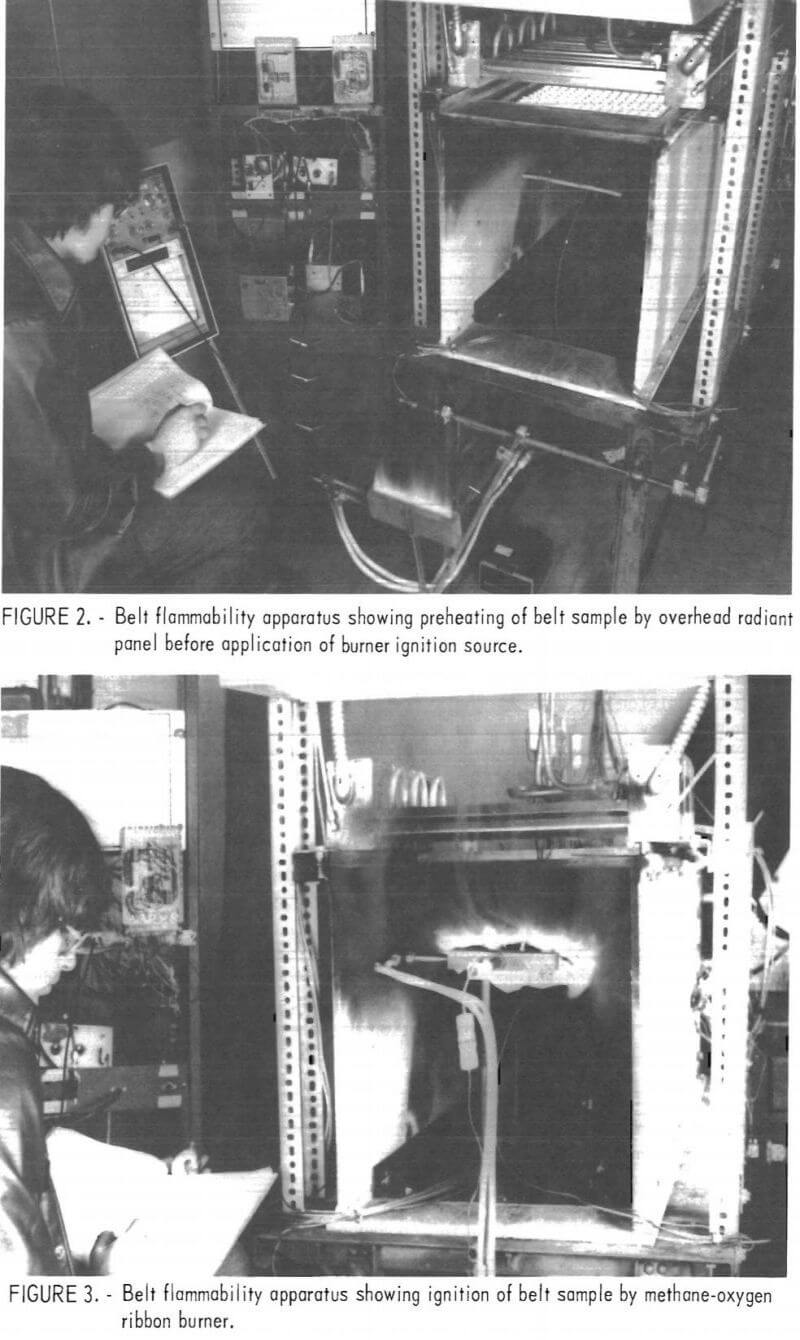
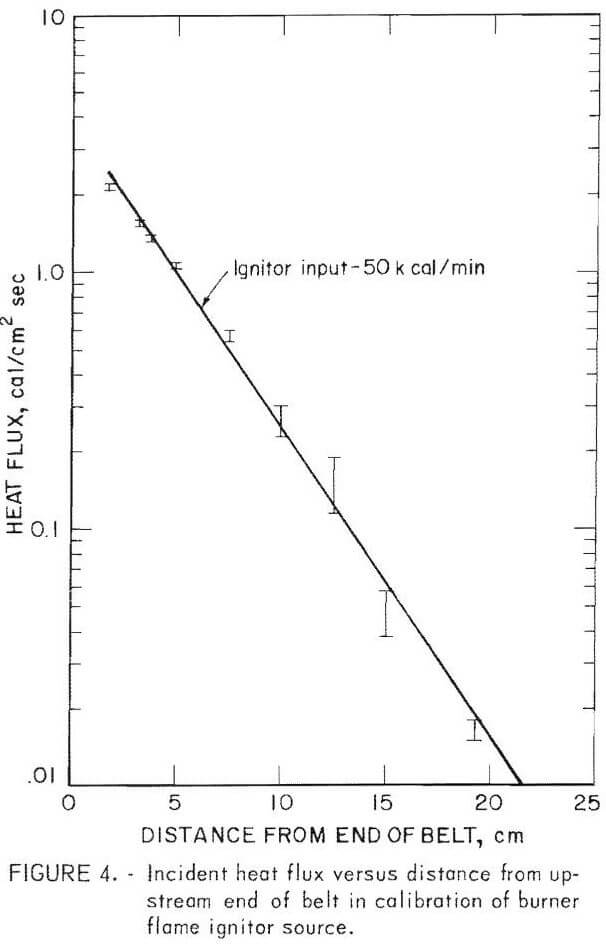 Calibration of Ignitor
Calibration of Ignitor
To fully characterize the ignitor source, it was necessary to calibrate the methane-oxygen burner in terms of the actual heat flux received by the belt. For this purpose, a total heat flux, water-cooled calorimeter was used. It was positioned flush with the surface of a simulated conveyor belt, which was made of a refractory material, and exposed to the burner flame. The heat flux measurements were made along the centerline of the simulated belt perpendicular to the central axis of the burner. Figure 4 shows the measured flux distribution with an ignitor input of 50 kcal/min and chamber air velocity of 30 m/min. The incident flux was over 2 cal/cm² sec at the upstream end of the belt and decayed exponentially to approximately 0.015 cal/cm² sec at 20 cm downstream; the extrapolated value at zero distance was 4 cal/cm² sec. Regression of these data gave the following exponential relationship:
Qign = 4.06 exp (-0.277x)……………………………………(2)
where Qign is heat flux in calories per square centimeter per second and x is the reference distance on the belt surface. From this relationship, it was calculated that 90 percent of the total heat received by the top surface of the belt was concentrated over a distance of 8.2 cm from the upstream end. This distance was also consistent with the extent of flame impingement that was observed visually. Therefore, the integrated mean of the flux distribution over this distance was used to characterize the ignitor source, as defined by

where Qign (x) is given by equation 2 and the limits of integration are 8.2 cm (b) and 0 (a).
Results of calculations by the above expressions indicated that a mean heat flux (Qign) of 1.6 cal/cm² sec was received by the belt at an ignitor input of 50 kcal/min. This value does not include the small amount of ignitor heat that is delivered to the bottom surface of the belt; this is estimated to be less than 10 percent of the total input. Thus, any uncertainty in the reported ignitor heat flux value should be relatively small.
Results and Discussion
Flame Spread
Temperature rise measurements in the test chamber proved to be sufficiently reproducible to provide a reliable measure of the extent and rate of flame spread of any belt sample. They were preferred to fuse wire break data because the latter only defined the flame arrival time at each test station, whereas the former provided a history of the flame development and could be used to characterize the heat release rate. Also, the fuse wire data were occasionally inconsistent because of false early triggering.
Typical temperature histories of the belt surface, gas stream, and chamber ceiling are shown in figures 5-6 to illustrate the varied temperature-time profiles under different ignition conditions in the present experiments; fuse wire times are also included. These data were obtained at three of the eight equally spaced monitoring stations in tests with A-PVC fire-resistant belts at ignitor inputs of 50 kcal/min (fig. 5) and 100 kcal/min (fig. 6), respectively. It is apparent that only the first station (41 cm), which was just beyond the preheated section being ignited, showed any detectable temperature rise during the period of preheating (15 min) with the radiant panel. Immediately after application of the ignitor flame to the belt surface, the temperatures increased with time at each station as the burning became more fully developed and spread downstream along the length of the belt. Arrival of flame at each station was indicated by an abrupt rise of the belt surface temperature and verified by comparison with the fuse wire break times (x symbols on abscissas). As expected, the flame arrival times were shorter with the more severe ignition condition (fig. 6). Generally, the gas stream temperatures were highest, ranging up to 500° to 700° C and nominally between 50° and 200° higher than the corresponding belt surface temperature. Chamber ceiling temperatures were lowest and lagged behind the other measured temperatures, the differences being greatest downstream of the initial monitoring station.
Flame spread rates were determined by linear regression of the flame arrival times and corresponding propagation distances, as derived from the temperature histories at the eight monitoring stations. In figures 5-6, the regressed rates are indicated by the straight lines that are drawn approximately through the inflection region of each belt surface temperature curve. These rates refer to those measured beyond station 1; that is, beyond the
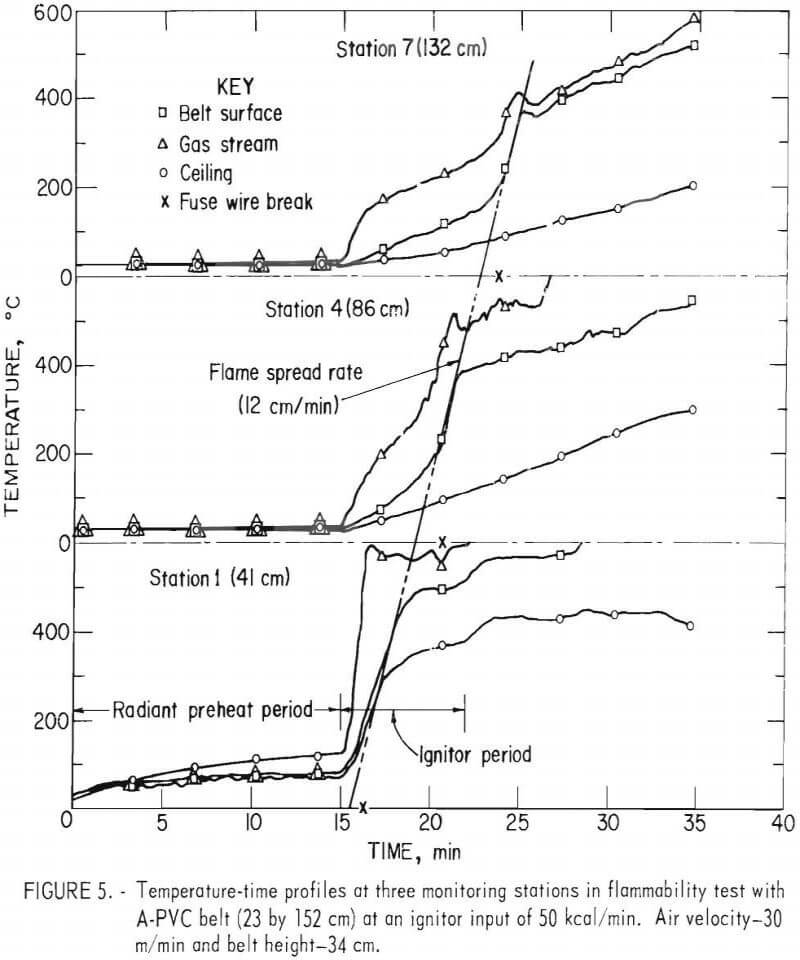
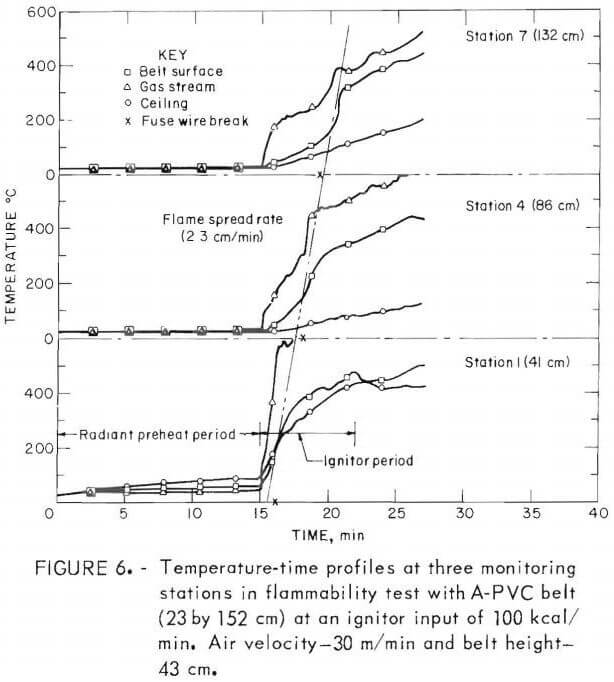 preheated belt section and after the propagation became sustained. They were essentially constant over the length of belt sample and agreed with the fuse wire data in all but a few cases. Since flame spread can vary with the ventilation rate, ignitor intensity, and other factors, it was important to determine the effects of test variables and the requirements for optimizing the test method.
preheated belt section and after the propagation became sustained. They were essentially constant over the length of belt sample and agreed with the fuse wire data in all but a few cases. Since flame spread can vary with the ventilation rate, ignitor intensity, and other factors, it was important to determine the effects of test variables and the requirements for optimizing the test method.
Tables 2-5 summarize data on the effects of test variables on the flame spread rate of an A-PVC belt in the new flammability apparatus. This belt was selected because it is a schedule 2G approved material and represents one of the widely used belts in coal mines. In evaluating the effect of each variable, the reference set of conditions were (1) radiant preheat flux of 0.1 cal/cm² sec for 15 min, (2) ignitor heat input (burner input) of 50 kcal/min for 7 min, (3) belt width of 23 cm, (4) belt height of 34 cm, and (5) air velocity of 30 m/min. These conditions were arrived at from a systematic study of the test variables. Since flame spread was measured from the first monitoring station beyond the preheated section (40 cm), a flame spread distance of 112 cm was indicative of propagation to the end (152 cm) of the sample.
Radiant Preheat Flux
Intensity and duration of the radiant panel preheat flux had no discernible effect on the flame spread of the A-PVC belt beyond the first monitoring station. As noted in table 2, flame spread rates at an ignitor input of 50 kcal/min varied only between 12 and 15.5 cm/min and displayed no consistent variation with increasing radiant flux levels (0, 0.1, and 0.2 cal/cm² sec) or the flux duration (<20 min). The only observed effect of the radiant pre-heating was a reduction in time for the incipient flame to develop and become sustained within the preheat zone; that is, during the ignition stage up to station 1. Nevertheless, the latter effect, was not pronounced and appeared evident only when the radiant heat flux was decreased from 0.1 to 0 cal/cm² sec.
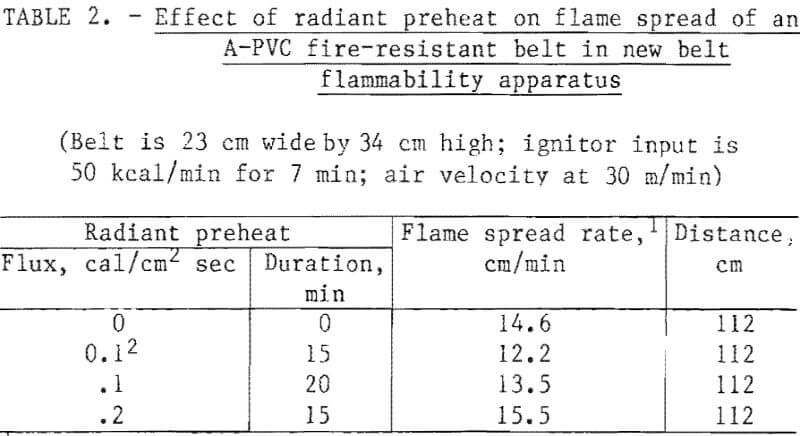
These results do not necessarily indicate that preheating effects can be neglected. Such effects should be expected to vary with the relative fire resistance of the belt material and to be greatest under marginal conditions for ignition or propagation. This is apparent from the large-scale test results of earlier investigators who reported reduced or no sustained flame propagation of certain fire-resistant belts without preheating the samples to approximately 235° C. In comparison, the more recent study by Factory Mutual has shown that preheating effects can be made negligible if the belt height conditions are optimized to insure maximum radiative and convective heat transfer to the belt surface. The latter results are consistent with those of the present work in which the belt height was increased to 34 cm to increase the radiation feedback. Data on belt height effect are fully discussed later. Essentially, the data indicate that the preheating effect is overshadowed by the greater effects resulting from optimizing the belt height and ignitor heat input. Thus, if the latter variables are optimum, it appears that belt preheating is not necessary to obtain a reliable measure of fire resistance by this method.
Ignitor Heat Input
Flame spread rates were strongly dependent upon the ignitor or burner heat input. Table 3 shows that the rates increased from zero to 23 cm/min when the ignitor input was varied from 25 to 100 kcal/min at the reference set of conditions. Increasing the ignitor input also increased the ease of ignition; for example, the time of flame detection at station 1 decreased from 6 to 2 min when the ignitor input was increased from 50 to 100 kcal/min. The duration of ignitor input had little effect on the flame spread until the exposure was reduced to 3 min, where no sustained propagation occurred. At the same time, this variable was important in defining the critical ignitor input for sustained propagation. Based on these data, an ignitor input of about 50 kcal/min and exposure time of at least 5 min appears necessary for evaluating belts of equivalent or less fire resistance than the A-PVC belt.
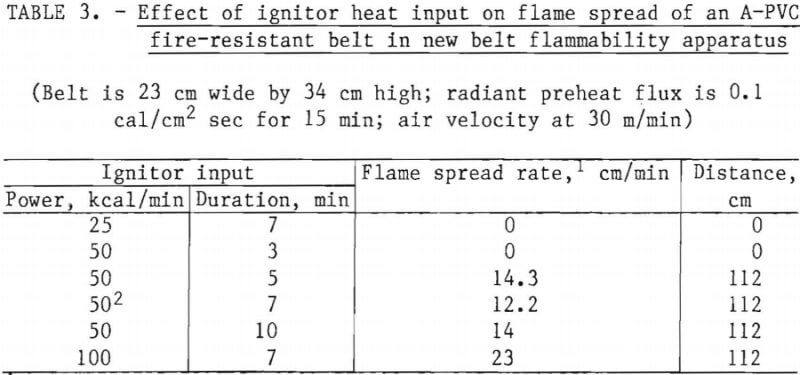
With belts of greater fire resistance than the A-PVC materials, ignition was not always obtained at an ignitor input of 50 kcal/min. However, all such belts were capable of sustained ignitions at 100 kcal/min. Similar trends were observed in the fire gallery tests with the same materials at Factory Mutual. The latter data will be discussed later in this report.
As indicated by the ignitor calibration data, an ignitor input of 50 kcal/min corresponded to a mean heat flux of 1.6 cal/cm² sec on the surface of the belt. This flux level is typical of the thermal radiation that could result in the immediate area of a fully developed coal fire and is more than adequate for igniting most combustibles. Thus, the above heat flux level is a realistic ignition condition in a mine whereas that corresponding to the 100-kcal/min ignitor input would generally be atypical and overly severe.
Belt Width and Height
Both belt width and height were important variables in these experiments. At the given ignitor input of 50 kcal/min, and belt height of 34 cm, sustained ignitions were obtained with the A-PVC belt in only one of four trials with a 15-cm-wide sample. Ignitions of 23- and 30.5-cm belts were readily achieved under the same conditions and resulted in flame spread rates of 12.2 and 14.3 cm/min, respectively. Apparently, the heat release rate for combustion of the smallest size belt (15 cm width) was insufficient to overcome the convective heat loss rate associated with this apparatus under the reference flow condition (30 m/min). In any event, a minimum belt width of about 23 cm appears suitable for this test since flame spread rate did not increase substantially when the belt width was increased by over 30 percent. The optimum belt width for propagation is strongly interrelated with the belt height and ventilation conditions of the system, as discussed herein.
Flame spread was very sensitive to the belt height. As noted in table 4, little or no flame spread was observed at belt heights of 23 and 30.5 cm; that is, at belt height-chamber height ratios (h²:h¹) of 0.5 and 0.66. However, when the belt was elevated to a height of 34 cm (h²:h¹ = 0.74), propagation occurred readily and gave a flame spread rate of 12.2 cm/min. This test condition could be considered more favorable for flame spread because of increased radiative and convective heat transfer to the belt surface. A further elevation of the belt to 40.5 cm (h²:h¹ = 0.88) resulted in a drastic reduction in the flame spread rate presumably because of reduced combustion air at the burning surface due to the more restrictive air circulating condition; also, conductive heat loss to the chamber ceiling cannot be ignored at such high ratios. The present results are roughly consistent with the Factory Mutual large-scale tests in which sustained propagation of fire-resistant belts was not obtained until h²:h¹ was increased from 0.5 to 0.66.
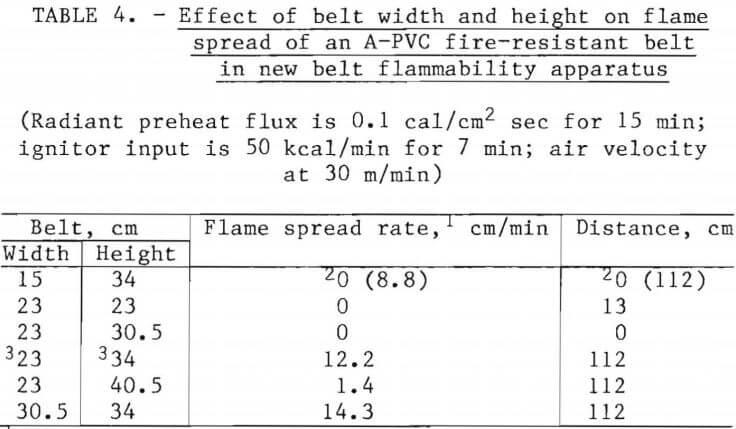
Figure 7 illustrates the relatively great effect of the radiative component (QR) of heat transfer, compared with the convective component (Qc), that can be expected under favorable burning conditions. The calculated heat flux components for the reference test condition with an A-NP belt are compared with the measured total heat flux (QT) at the belt surface, 90 cm from the ignited end. Average belt surface temperature (TR,) and gas stream temperature (Tb) between stations 4 and 5 were used in these calculations as follows:
QT = Qc + QR…………………………………………………….(4)
Qc = h (Tg – Tb)……………………………………………………(5)
where temperature (T) is in kelvin and the heat transfer coefficient (h) is calories per square centimeter per second per kelvin. The heat transfer coefficient was determined by first considering that heat transfer to the downstream stations just after application of the ignitor was only by convection, that is, QT = Qc. From the early temperature measurements, the heat transfer coefficient averaged 2.65 x 10 -4 cal/cm² sec K. This value was assumed constant throughout the period of flame travel to the downstream
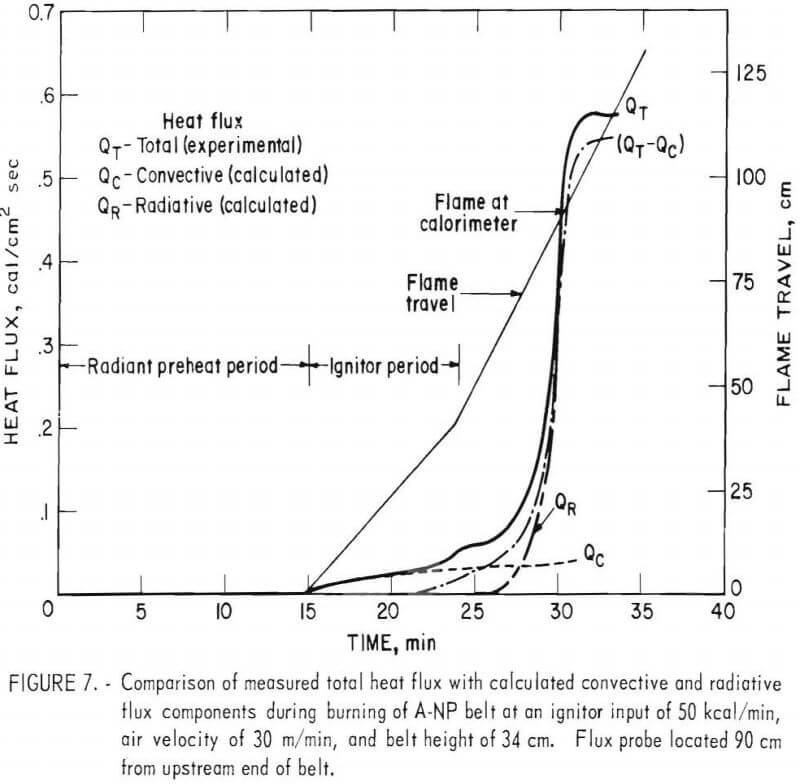
monitoring stations (4 and 5). During the various stages of burning, the radiative heat transfer component was determined by difference (QT – Qc) and by an independent calculation based upon the radiation view factor. According to Hottel,
QR = σ F12 T4……………………………………..(6)
where σ is the Stefan-Boltzman constant (1-35 x 10 -12 cal/cm² sec K4), T is flame temperature (K), and F12 is a geometrical radiation view factor between two perpendicular planes. Here, the F12 view factor was more complicated and calculated by assuming one plane represented a flat flame front approaching the flame sensor and the other plane corresponded to the belt surface.
As shown in figure 7, convective heat transfer accounts largely for the total thermal flux transmitted downstream during the ignition period. Subsequently, as flame propagated toward the monitoring sensor, the radiative heat transfer component progressively increased and comprised about 90 percent of the total measured heat flux when the flame reached the heat flux calorimeter. Differences between the QR values by equation 6 and those inferred from experimental measurement (QT – Qc) can be partly attributed to the uncertainties involved in estimating the view factor (F12) and flame temperature (T).
Since radiation feed-back will also increase with the width of the burning surface, some correlation should exist between the ease of flame propagation and the ratio of belt width to distance between the belt and the ceiling. This was borne out by the moderate- and large-scale test data obtained with the A-PVC conveyor belt (table 5). The critical ratio below which flame propagation did not occur was 1.3 to 1.5 in the present laboratory-scale apparatus. This value compares favorably with the corresponding value of 1.27 found in the full-scale experiments. Host small-scale flammability test methods have not considered this effect although this criticism can also be made of some large-scale methods.
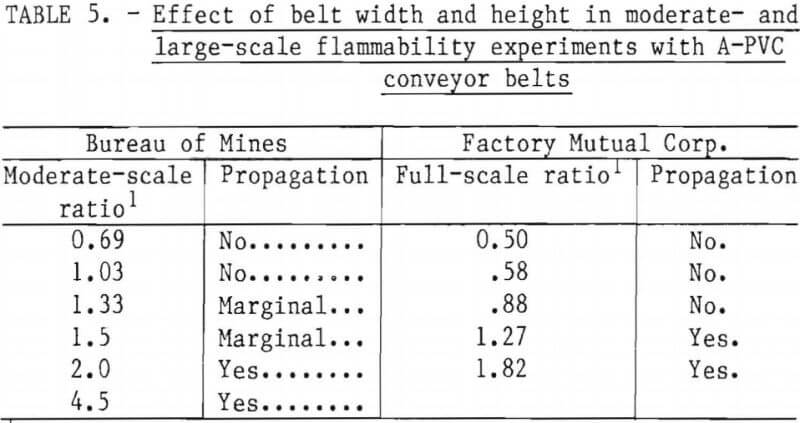
Air Velocity
Ventilation rate had two different effects in these experiments, as expected. With increasing air velocity, the flame spread rate increased because of increased mass transfer of oxygen to the burning surface and because of increased heat transfer to the downstream unburned surface by convection; the burning is also enhanced because the flame front becomes more inclined toward the unburned surface with increased air velocity. However, above some critical air velocity, ignition is not possible because of excessive convective heat losses or simple flame blowoff conditions.
In the present experiments (table 6), the flame spread rate of the A-PVC belt at the reference test conditions increased from 8.2 to 12.2 cm/min when the air velocity was varied from zero to 30 m/min. Interestingly, ignitions were not achieved when the air velocity was doubled or more, indicating a scale limitation of the proposed apparatus. However, the data also show that once ignition is obtained at a given air velocity, the flame spread rate can be substantially higher with a subsequent increase of air velocity; note that flame spread rates of 80 and 120 cm/min were obtained at air velocities of 60 and 90 m/min, respectively, after ignitions at 30 m/min. Although flame spread rate can be accelerated with variation of air velocity during an experiment, it was considered best to select a fixed velocity condition that would not be too severe for ignition but still suitable for evaluating the flame spread hazard. Therefore, an air velocity of 30 m/min was selected as the reference velocity condition to compare various belts, although this should not be assumed to represent the condition of maximum possible flame spread. The effect of other air velocities should always be investigated when fully evaluating the fire hazard.
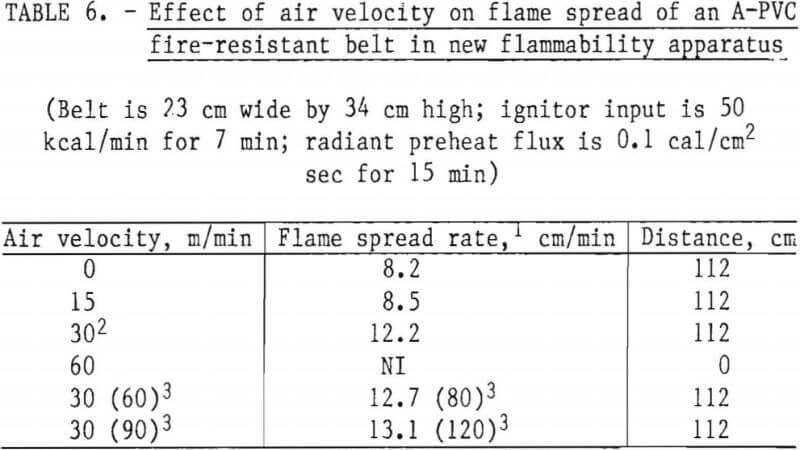
Belt Material
For meaningful comparisons, the flame spread rates of different belt materials were determined under the same reference set of test conditions defined at the outset of this section. These rates were obtained from linear regression of the distance-time data which gave the straight line plots shown in figure 8. In this figure, the ignition stage is depicted by the dashed-line portion of each curve and the propagation stage by the solid-line portion. All belts were capable of ignition at an ignitor input of 50 kcal/min except the C-PVC belt, which required 100 kcal/min but still had the lowest flame spread rate (4 cm/min). The A-PVC belt had the highest flame spread rate (12.2 cm/min) and the neoprene (A-NP and B-NP), fire-resistant rubber (A-FRR), and another polyvinyl chloride belt (B-PVC) had intermediate values. Differences in carcass composition appear to account for the varied results obtained with the A-NP (nylon) and B-NP (nylon-polyester) belts which are manufactured by the same vendor; fire resistance was greater with the nylon-polyester carcass.
It is important to note that the flame spread rate during the ignition stage will not necessarily be indicative of the rate during fully developed combustion. For example, compare the curves for A-PVC and A-NP which tend to have nearly the same flame spread rate beyond the first monitoring station in figure 8, but display widely different rates during the early combustion stage. This behavior illustrates the importance of including an ignition factor and propagation factor in any fire resistance rating.
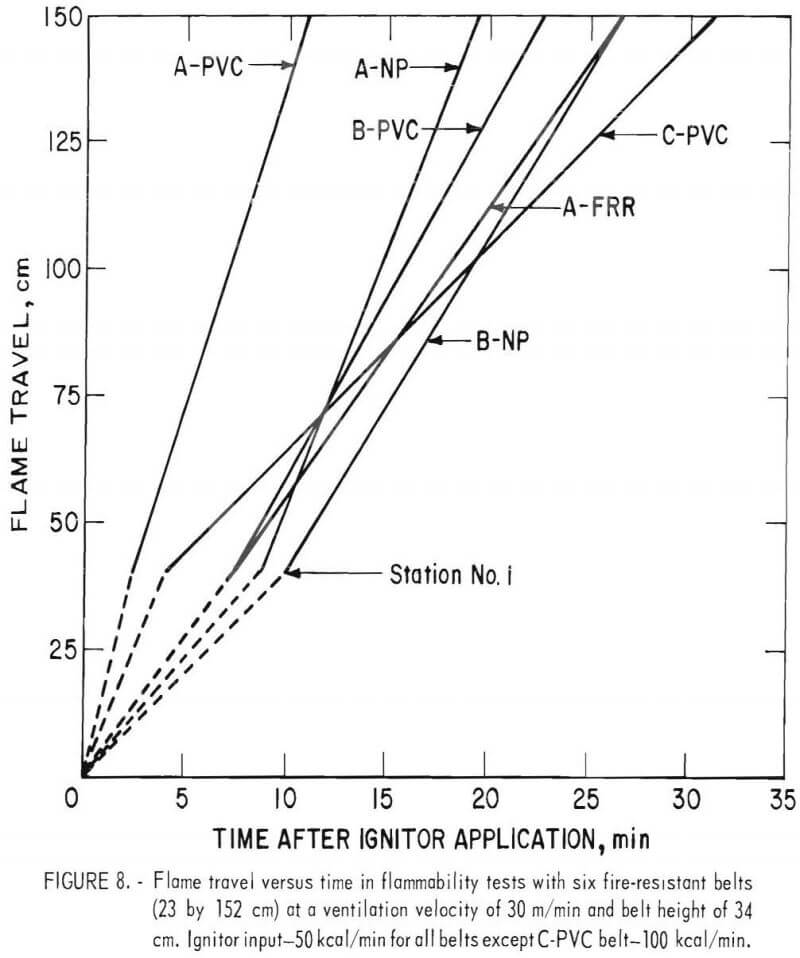
Smoke Emission
All belts that ignited in the flammability tests generated relatively high concentrations of smoke particulates. Generally, the smoke concentration gradually increased to a maximum following ignition and then leveled off.
Based upon the measured light transmission (I/Io), the B-PVC and B-NP belts gave the most smoke and the C-PVC and D-PVC the least smoke at the reference test conditions (ignitor input = 50 kcal/min); the C-PVC belt, which ignited only when the ignitor input was increased to 100 kcal/min, gave an intermediate I/I0 value at the higher heat flux. These data are summarized in table 7 and are also given in terms of a smoke index that is equal to the attenuation coefficient (k) in equation 1.
k = log(Io/I)/0.434l……………………………………………………(9)
where the beam path (l) is 15.2 cm.
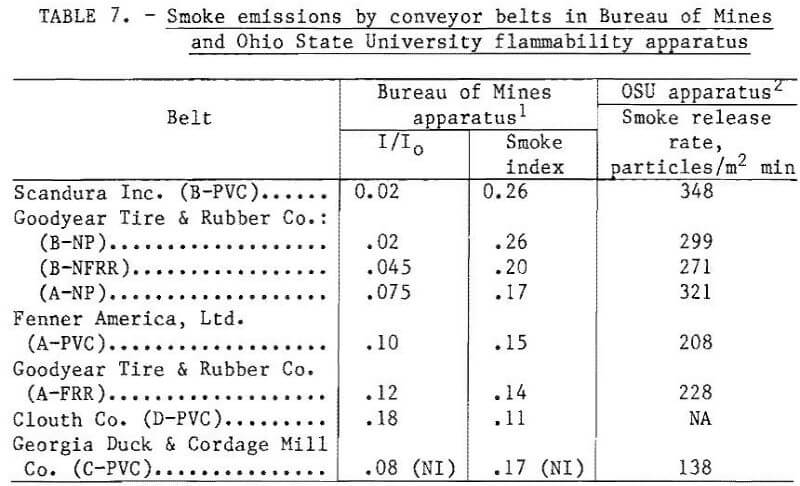
Also included in table 7 are smoke release rate data (particles per square centimeter per minute) that were obtained by a commercial laboratory (Smithers Scientific Services) using the Ohio State University heat release rate apparatus. The belt smoke rankings by the two different methods agreed fairly well except in the case of the A-NP belt.
In comparing these data with fire resistance data, it is evident that the smoke index or smoke release rate does not always correlate with the flame spread rate or heat release rate of the belt material. Note, for example, that the B-PVC and A-FRR belts have widely different smoke indices (table 7), whereas both belts have relatively low flame spread rates (table 8). Thus, it cannot always be assumed that the smoke emission will be greatest with the least fire-resistant material.
Fire Resistance Ratings by New Apparatus
To provide more reliable fire resistance ratings for conveyor belts, it was essential to include factors that reflect the hazard level for both ignition and flame propagation stages of combustion. Also, the ratings need to be quantitative to make useful comparisons. The following three factors were considered necessary for this purpose:
- Critical heat input for sustained ignition (I).
- Flame spread rate at critical ignitor heat input (FS).
- Heat release rate at critical ignitor heat input (Qf).
Since ignition depends upon the magnitude and duration of the ignitor heat flux (Qign), both were included in defining the critical ignitor heat input. Essentially, this required the use of a time-integrated heat flux (Qign x t) to determine the I quantity. The (I) quantity was determined by fixing the ignitor flux at a relatively high but realistic value (1.6 cal/cm² sec) and varying the exposure time. Similarly, it was necessary to select test conditions that would optimize the flame propagation stage. These reference test conditions were
- Belt width of 23 cm.
- Belt height (h¹) of 34 cm (h¹/h² = 0.74).
- Air velocity of 30 m/min.
- Radiant preheat flux of 0.1 cal/cm² sec for 15 min.
- Burner input of 50 kcal/min and equivalent to ignitor heat flux of 1.6 cal/cm² sec (Qign).
The ignitor heat flux value of 1.6 cal/cm² sec is nearly equal to the maximum thermal radiation that is possible from a fully developed coal fire (-2 cal/cm² sec). Thus, the ignition condition selected to evaluate the belts is not unrealistic or overly conservative.
Table 8 summarizes the data obtained for the various conveyor belts under these reference test conditions; data are also included for red oak as a reference standard material. All of the fire-resistant belts in this table passed the schedule 2G test. In comparing these data, it is apparent that the fire resistance rankings indicated by each of the rating factors (I, FS, and Qf) are not in full agreement. For example, the A-PVC and A-FRR belts have the same I value but noticeably different FS and Qf values. Also, the B-NFRR and A-NP belts have approximately the same FS values but significantly different I and Qf values. This illustrates how fire resistance ratings can be misleading if both ignition and flame propagation stages are not considered.
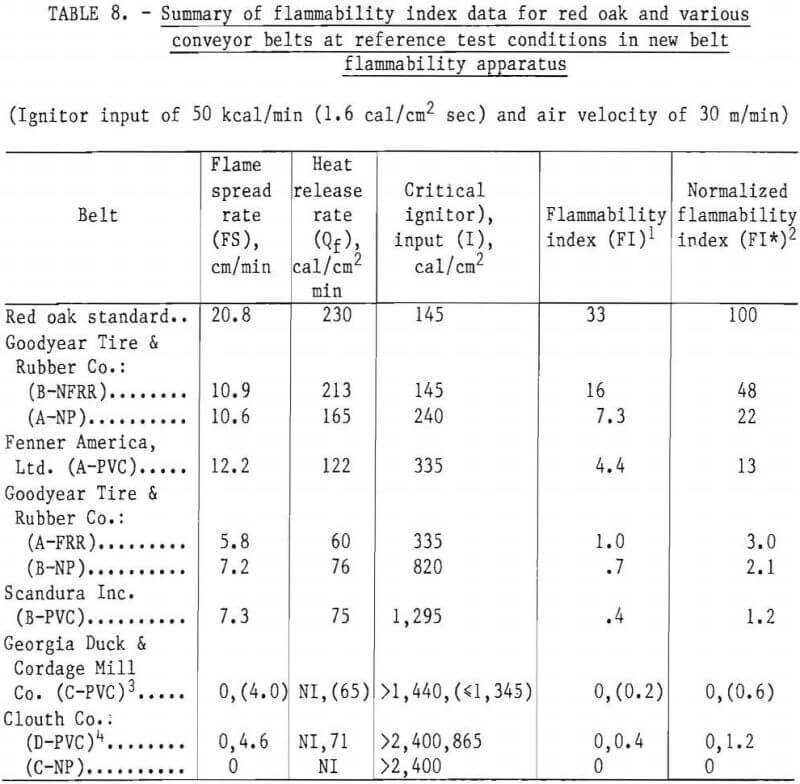
A belt flammability index (FI) is proposed that is directly proportional to the product of the flame spread and heat release rates and inversely proportional to the critical ignitor heat input
FI = FS x Qf ; I = Qign x t……………………………………………………(7)
where FS (centimeters per minute), Qf (calories per square centimeter per minute), and I (calories per square centimeter) are determined under the reference test conditions at an ignitor heat flux (Qign) of 1.6 cal/cm² sec. For more meaningful comparison, this index was normalized with respect to red oak as
FI* = 100 FI (Belt)/FI (Red Oak)…………………………………………..(8)
By this scheme, the flammability index of the red oak standard is 100 compared with 48 for the B-NFRR belt and zero for the C-PVC, D-PVC, AND C-NP belts. Both FI and FI* values for the belts are given in table 8. Thus, belts with an FI* of less than 10 or so can be considered to be highly fire resistant and safe for mine use. In comparison, a belt with an FI* value of greater than 10 (that is, greater 20 percent of the FI* value for a nonfire-resistant belt) should be considered suspect or at least borderline in its fire resistance.
The belt manufacturer’s quality control is a factor of great uncertainty and can understandably affect the reproducibility of such data. Therefore, it is important to determine the variation of a belt’s flammability rating with different batches of the vendor’s product and when any changes are made by the vendor in the chemical or physical processing of a particular belt. Changes in the belt plasticizer and carcass composition can especially affect the results.
Although the most highly fire-resistant belts did not ignite at the reference ignitor heat flux condition (50 kcal/min or 1.6 cal/cm² sec), such belts could be ignited at more severe ignitor flux levels. This was investigated with the C-PVC belt which was shown to be capable of ignition when the ignitor heat flux was increased from 1.6 to 3.2 cal/cm² sec (table 8); these heat flux values correspond to burner inputs of 50 to 100 kcal/min, respectively. However, the increase in ignitor flux had a negligible effect on the belt flammability index. Furthermore, data at this higher ignitor heat flux are primarily of academic interest since such flux levels are only encountered in a severe mine fire situation.
Reproducibility of the test data was largely determined with the A-PVC belt. The critical ignitor inputs were reproducible within ±20 percent at the low level (200 cal/cm²) and within ±10 percent at the high level (>1,000 cal/cm²). Flame spread rates and heat release rates were precise within ±10 percent over the range of test values.
Comparison of Fire Resistance Ratings With Other Methods
The belt fire resistance ratings obtained by the present method are compared with those found by other methods in table 9. This table includes data from the full-scale fire tests by Factory Mutual for some of the conveyor belts that are compared here. Although the latter data were not precisely defined and only indicate the approximate ignitor heat input (kilocalories per minute) required to obtain sustained flame propagation, they were roughly consistent with the order of flammability rankings obtained in the Bureau work. Only the rankings obtained for the A-NP belt appeared to differ noticeably by these two methods. Better agreement would have resulted if the rankings by the full-scale tests had included flame spread rate and the exposure time required to achieve ignition at the given ignitor input, as was done in the Bureau work. Also, ignitor input was only grossly defined in the full-scale tests.

Other fire resistance ratings in table 9 are by small-scale test methods, each of which has certain deficiencies that limit their usefulness. The ASTM E 2863 oxygen index method suffers because it relies upon the least favorable mode of flame spread (downward direction) with a small-size sample and yields ratings that are not sufficiently discriminating. Ratings by this method for the A-NP, A-PVC, B-PVC, and C-PVC belts are inconsistent with most of the data trends in table 9. The ASTM E 16219 flame spread method also utilizes the downward mode of flame propagation and, therefore, cannot be considered to provide conservative estimates of the flame spread hazard. This method gave questionable rankings particularly to the A-NP and B-PVC belts; an index of about 25 to 50 would be indicative of moderate fire resistance by this method.
The MSHA schedule 2G acceptance method has the usual limitations expected with a small-scale flammability test, including an inadequate ignition source. Approval criteria for acceptance of a belt are flame duration below 1 min and glow duration below 3 min. The fire resistance reflected by the flame duration criterion were either very low (long duration) for the B-NFRR belt or very high (short duration) for all the “approved” fire-resistant belts in table 9. Overall, this method is poor for discriminating between fire-resistant belts and tends to yield higher fire resistance ratings than obtained by other methods.
The Ohio State University heat release rate method suffers largely because the critical ignitor input is not included and the flame spread rate is only partly reflected in the heat release rate. Ratings by this method were questionable for the A-NP and B-NP belts; note that practically no difference was found between the B-NFRR and the A-NP belts. The Bureau belt rankings indicated by the use of heat release rate alone (table 8) were roughly consistent with the OSU data.
Fire resistance ratings by the Bureau of Mines method overcome the serious deficiencies of existing small-scale methods and provide the most reliable measure of the potential fire hazard that may be practically encountered with mine conveyor belts. Since the proposed hazard index is for an air ventilation rate of 30 m/min and can be greater at higher rates, assuming ignition is possible, it is recommended that the effect of increased air velocity be determined at the maximum velocity of interest. This particularly important in the case of those belts with a marginal flammability index, that is, an FI* value on the order of 10 to 20. A great advantage of this test method is that is permits comparison of the flame spread, heat release, and ignition factors that determine the potential fire hazard of a belt. Thus, belt ratings can be compared on the basis of a single factor (table 8) or by the combined contribution of all three factors as indicated by the FI* index (table 8 or 9).
Conclusions and Recommendations
An improved fire resistance test method was developed to evaluate the potential fire hazard of mine conveyor belts. It employs a moderate-scale apparatus that was designed from full-scale fire data to overcome the practical limitations of current laboratory methods. The critical variables were air velocity, ignitor heat input (burner flame), belt width, and belt proximity to the top of the test chamber; the last parameter controls the amount of radiation feed-back to the burning belt, which is an important consideration in real fire situations. Results of this work indicated that an ignitor input of 50 kcal/min was adequate for igniting most belts and that a belt width-chamber width ratio of at least 0.5 and belt height-chamber height ratio of about 0.75 were optimum for achieving sustained flame propagation; also, an air velocity of at least 30 m/min appeared necessary for such evaluations. Based upon data obtained for various rubber, neoprene, and polyvinyl chloride belts, the proposed method gives more reliable fire resistance ratings than those obtained by MSHA’s Federal Schedule 2G method and other laboratory-scale methods.
One of the attractive features of this method is that it provides quantitative fire resistance ratings which reflect both ignitability and flammability (flame propagation) characteristics of the material. The use of a relatively long belt sample (1.5 m) makes it possible to consider both stages of combustion in the rating scheme. Three criteria are recommended for defining the fire resistance rating, namely, integrated ignitor heat flux for sustained propagation (I), flame spread rate (FS), and heat release rate (Qf).
Both flame spread and heat release parameters are included because surface propagation rates of all belts do not necessarily vary in direct proportion to their heat release rates, which reflect total mass consumption rates. The three criteria are combined to provide a flammability index (FI = FS x Qf/I) that is normalized with respect to red oak as the reference standard. The proposed test method and rating scheme is sufficiently sensitive to discriminate between belts of low, moderate, and high fire resistance and is recommended for updating the small-scale, schedule 2G approval method.
By the proposed rating scheme, the normalized flammability index (FI*) was 100 for red oak, approximately 50 for a nonfire-resistant rubber belt, between 10 and 25 for belts of moderate or marginal fire resistance, and less than 10 for highly fire-resistant belts. Both PVC and neoprene belts appeared to be more fire-resistant with a polyester or polyester-nylon carcass than with a nylon or nylon-cotton carcass. The most fire-resistant belts were an American PVC belt (Georgia Duck), which was formulated to meet Canadian specifications, and two German PVC and neoprene belts (Clouth). Because of the uncertainty of the vendor’s quality control, it is necessary to determine fire resistance ratings with different batches of belt material and whenever the vendon makes any changes in the chemical or physical manufacturing processes.
This research has primarily emphasized the measurement of the fire resistance characteristics of mine conveyor belting. To fully determine the potential fire hazard of such materials, it is also necessary to evaluate the smoke and toxicity hazard that may be associated with the fire products.
